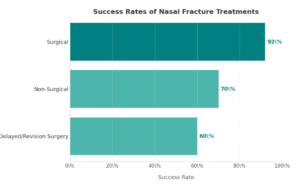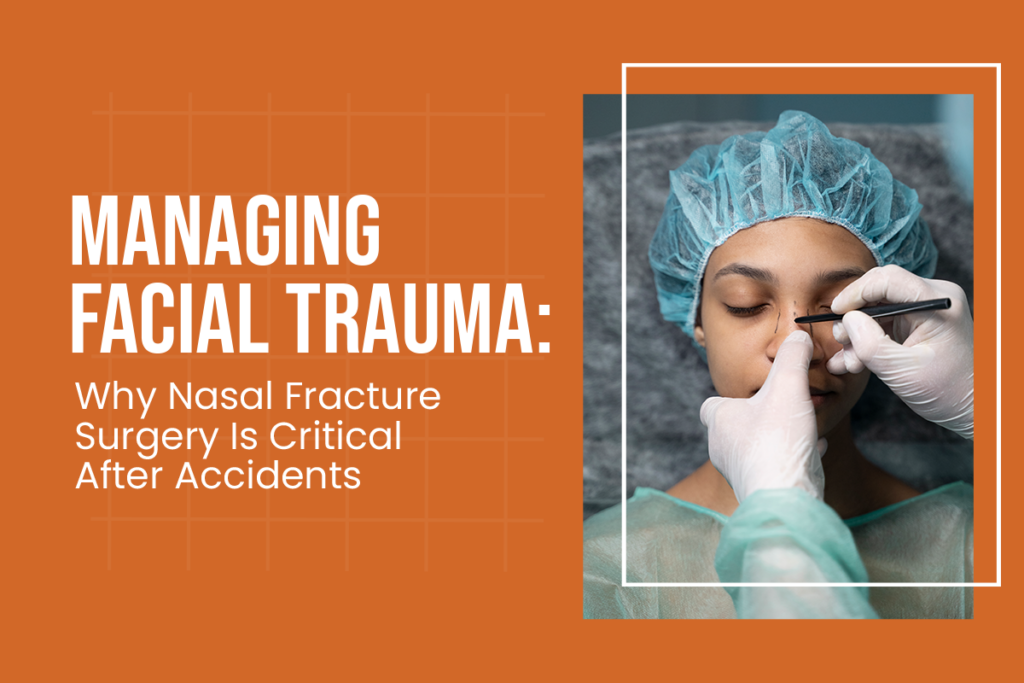Facial trauma from vehicle accidents, sports injuries, or falls can be frightening and painful. Among all facial injuries, nasal fractures are the most common, accounting for over 40% of facial trauma cases according to medical research. While some people assume a broken nose will heal naturally, untreated nasal fractures can lead to serious long-term complications including breathing difficulties, chronic pain, and permanent facial deformity.
Dr. Sudarshan Aahire, a highly experienced ENT surgeon in Nashik, has treated hundreds of nasal fracture cases resulting from accidents. His expertise reveals that timely intervention through nasal fracture surgery often makes the difference between complete recovery and lifelong problems. Understanding when surgery becomes necessary and what the procedure involves can help accident victims make informed decisions about their facial trauma treatment.
Understanding Facial Trauma and Nasal Fractures
What Happens During Facial Trauma?
Facial trauma involves any injury to the face, including the soft tissues, bones, and structures like the nose, jaw, and eye sockets. Vehicle collisions remain the leading cause, followed by sports injuries, falls, and workplace accidents. The nose’s prominent position on the face makes it particularly vulnerable to impact.
When significant force strikes the nose, the delicate nasal bones can crack or completely break. The nasal septum, the cartilage dividing the nostrils, may also become displaced or damaged. Research indicates that males aged 15-30 experience the highest rates of nasal fractures, primarily due to sports participation and motor vehicle accidents.
Types of Nasal Fractures
Simple fractures involve a clean break without displacement, while comminuted fractures shatter the bone into multiple pieces. Compound fractures pierce through the skin, creating additional infection risks. The severity and type of fracture determine whether nasal fracture surgery becomes necessary.
Septal injuries accompanying nasal bone fractures require special attention, as they directly impact breathing function and future nasal structure stability.
Why Is Nasal Fracture Surgery Important?
Preserving Breathing Function
The primary medical reason for nasal fracture surgery involves preserving or restoring normal breathing function. When nasal bones heal in displaced positions, they can narrow airways and obstruct airflow permanently. Studies show that approximately 30% of patients with untreated nasal fractures develop chronic nasal obstruction requiring eventual surgical correction.
Dr. Sudarshan Aahire emphasizes that breathing problems don’t always appear immediately. Many patients notice gradual worsening over months or years as scar tissue forms and structures settle into abnormal positions.
Preventing Permanent Deformity
Facial trauma treatment addressing nasal fractures prevents visible deformities that affect self-confidence and quality of life. The nose is a defining facial feature, and even slight asymmetry or deviation becomes noticeable.
Post-trauma nasal correction becomes significantly more complex and less successful when performed months or years after injury, as bones completely heal in displaced positions requiring re-breaking (osteotomy) for correction.
Avoiding Chronic Complications
Untreated nose fracture after accident can lead to multiple long-term problems:
- Chronic sinusitis from impaired sinus drainage
- Sleep-disordered breathing including snoring and sleep apnea
- Recurrent nosebleeds from abnormal airflow patterns
- Chronic headaches due to sinus pressure
- Septal perforation requiring complex reconstruction

Procedure Overview: How ENT Surgeons Repair Nasal Fractures?
Initial Assessment and Diagnosis
Physical examination assessing visible deformity, swelling, bruising, and tenderness. Nasal endoscopy provides internal visualization of septal position and mucosal damage. CT imaging offers detailed bone and cartilage assessment for complex fractures requiring precise surgical planning.
Timing considerations are crucial, optimal intervention occurs either immediately (within 2-3 hours before significant swelling) or after swelling subsides (5-7 days), but before bone healing begins (typically within 10-14 days).
Surgical Techniques for Nasal Bone Repair
Closed reduction represents the most common approach for simple fractures without extensive comminution. This minimally invasive technique involves:
- Administering local or general anesthesia
- Manually repositioning bone fragments to their correct positions
- Placing internal splints or packing for support
- Applying external nasal splint for protection
Open reduction with internal fixation becomes necessary for complex fractures with multiple bone fragments. This approach provides direct visualization and precise positioning, though it requires slightly longer recovery.
Septoplasty may accompany nasal fracture surgery when septal deviation requires correction for optimal breathing restoration.
What to Expect During Surgery
Nasal fracture surgery typically takes 30-90 minutes depending on complexity. Most procedures occur under general anesthesia, though simple reductions may use only local anesthesia with sedation.
Post-operatively, patients wear external splints for 7-10 days while internal healing progresses. Most people experience moderate discomfort rather than severe pain, manageable with prescribed medications.
Benefits of Early Surgery and Risks of Delay
Advantages of Timely Intervention
Early nasal fracture surgery within the optimal timeframe (7-14 days) offers multiple benefits:
Higher success rates reaching 85-90% compared to delayed reconstruction (60-70% success). Faster recovery as fresh injuries heal more quickly than re-broken bones. Better functional outcomes with optimal breathing restoration. Reduced complexity avoiding need for cartilage grafting or extensive reconstruction.
Cost-effectiveness as primary repair costs significantly less than delayed reconstruction requiring multiple procedures.
Consequences of Delayed Treatment
Waiting too long for facial trauma treatment creates several challenges:
Complete bone healing within 3-4 weeks makes repositioning impossible without re-breaking. Scar tissue formation complicates surgical access and healing. Progressive deformity as improperly healed structures continue shifting over time. Secondary functional problems including chronic sinusitis and breathing difficulties.
Dr. Sudarshan Aahire notes that patients returning years after injury often require more extensive, expensive, and complex procedures with less predictable outcomes.
Comparing Treatment Approaches
| Treatment Type | Average Recovery Time | Success Rate | Pain Level (1–5) | Best For |
| Non-Surgical (Manual Adjustment) | 2–3 weeks | 70% | 2 | Minor fractures without displacement |
| Nasal Fracture Surgery (Closed Reduction) | 1–2 weeks | 90% | 3 | Moderate displaced fractures |
| Open Surgical Repair | 2–4 weeks | 85–95% | 4 | Complex or comminuted fractures |
Recovery and Aftercare Tips
Immediate Post-Operative Care
First 48 hours require careful attention:
- Keep head elevated to minimize swelling
- Apply cold compresses to reduce inflammation
- Avoid nose blowing or strenuous activities
- Take prescribed pain medications as directed
- Monitor for excessive bleeding or breathing difficulties
Days 3-7 involve gradual improvement with decreasing swelling and discomfort. Most bruising fades significantly during this period.
Long-Term Recovery Guidelines
Week 1-2: External splint removal, gentle resumption of daily activities avoiding contact sports or strenuous exercise.
Week 3-6: Gradual return to normal activities with continued protection from potential impact.
Month 2-3: Most swelling resolves, revealing final structural results.
Month 6-12: Complete tissue remodeling and final aesthetic outcome.
Activity Restrictions
Avoid these activities during recovery:
- Heavy lifting or straining
- Contact sports for 6-8 weeks
- Swimming for 2-3 weeks
- Wearing glasses directly on nose bridge (use forehead support)
- Vigorous nose blowing
Emergency Warning Signs
Seek immediate medical attention for:
- Severe, persistent bleeding not controlled by pressure
- Clear fluid drainage from nose (potential cerebrospinal fluid leak)
- Vision changes or eye movement problems
- Severe headache or confusion
- Difficulty breathing despite open airways
Urgent Consultation Indicators
Contact Dr. Sudarshan Aahire promptly if you experience:
- Visible nose deformity or deviation after facial trauma
- Breathing difficulties through one or both nostrils
- Persistent pain beyond normal post-injury discomfort
- Facial numbness or altered sensation
- Suspected nasal fracture requiring expert evaluation
Protect Your Future with Expert Care
Facial trauma involving nasal fractures requires prompt, expert evaluation to prevent lifelong complications. While the injury may seem minor initially, untreated or improperly treated nasal fractures can cause permanent breathing problems, chronic sinus issues, and visible deformity affecting self-confidence and quality of life.
Early consultation enables timely intervention when treatment is simplest and most effective. Contact Dr. Sudarshan Aahire today for expert evaluation and personalized nasal bone repair treatment ensuring optimal recovery and long-term nasal health.
If you’ve experienced a facial injury, consult Dr. Sudarshan Aahire, leading ENT surgeon in Nashik, for expert nasal fracture treatment and recovery guidance. Schedule your appointment today for comprehensive facial trauma care.
Frequently Asked Questions
Q: How do I know if my nose is fractured after an accident?
A: Signs of nasal fracture include immediate severe pain, visible deformity or deviation, swelling and bruising, difficulty breathing through the nose, bleeding, and crackling sounds (crepitus) when touching the area. Any nose fracture after accident with these symptoms requires prompt evaluation by an ENT surgeon in Nashik like Dr. Sudarshan Aahire for proper diagnosis and treatment planning.
Q: Can nasal fractures heal without surgery?
A: Minor, non-displaced nasal fractures can heal naturally with supportive care. However, displaced fractures causing breathing problems or visible deformity typically require nasal fracture surgery for optimal outcomes. Only 30-40% of nasal fractures heal satisfactorily without intervention. Professional assessment determines whether conservative management suffices or surgery becomes necessary.
Q: How long does it take to recover from nasal fracture surgery?
A: Most patients resume normal daily activities within 1-2 weeks after nasal bone repair surgery. External splints remain for 7-10 days, with most swelling resolving within 2-3 weeks. Complete bone healing requires 6-8 weeks, and final aesthetic results appear after 6-12 months as residual swelling completely resolves.
Q: Is nasal fracture surgery painful?
A: Nasal fracture surgery causes moderate discomfort rather than severe pain for most patients. Pain levels typically rate 3-4 out of 10 and are well-managed with prescribed medications. Closed reduction procedures generally cause less discomfort than open surgical repairs. Most patients describe pressure and congestion sensations rather than sharp pain during recovery.
Q: Can untreated nasal fractures cause breathing problems?
A: Yes, untreated nose fracture after accident leads to chronic nasal obstruction in approximately 30% of cases. Displaced bones and septal deviations narrow airways, causing persistent breathing difficulties, chronic sinusitis, sleep-disordered breathing, and recurrent infections. These problems often worsen over time and may eventually require more complex surgical correction than early intervention would have needed.
Q: When should I visit an ENT surgeon in Nashik after facial trauma?
A: Visit Dr. Sudarshan Aahire immediately after facial trauma if you notice visible nose deformity, severe bleeding, breathing difficulties, clear nasal drainage, vision changes, or severe headache. For less urgent symptoms, consultation within 24-48 hours ensures proper evaluation before significant swelling develops. Optimal nasal fracture surgery timing occurs within 7-14 days of injury.
Q: What precautions should I take after nasal fracture surgery?
A: After nasal bone repair, keep your head elevated, avoid nose blowing for 7-10 days, refrain from strenuous activities for 2-3 weeks, protect your nose from potential impact for 6-8 weeks, take medications as prescribed, attend all follow-up appointments, and avoid wearing glasses directly on the bridge until cleared by your surgeon.
Dr. Sudarshen Aahire is a young, talented, and vibrant ENT and Pediatric doctor in Nashik with 12 years of experience. Apart from routine ENT care and surgeries he specializes in the management of Snoring and obstructive sleep apnea surgeries, Endoscopic skull base surgeries, voice-related disorders, and voice surgeries, airway and swallowing disorders.


